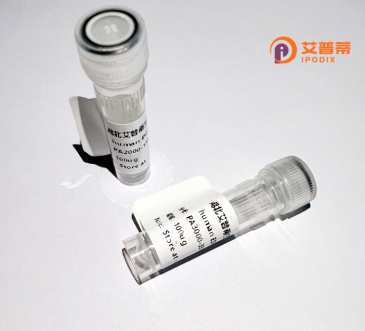
| 纯度 | >90%SDS-PAGE. |
| 种属 | Human |
| 靶点 | GAGE12B |
| Uniprot No | A1L429 |
| 内毒素 | < 0.01EU/μg |
| 表达宿主 | E.coli |
| 表达区间 | 1-117aa |
| 氨基酸序列 | MSWRGRSTYYWPRPRRYVQPPEMIGPMRPEQFSDEVEPATPEEGEPATQCQDPAAAQEGEDEGASAGQGPKPEAHSQEQGHPQTGCECEDGPDGQEMDPPNPEEVKTPEEGEKQSQC |
| 分子量 | 39.3 kDa |
| 蛋白标签 | GST-tag at N-terminal |
| 缓冲液 | 0 |
| 稳定性 & 储存条件 | Lyophilized protein should be stored at ≤ -20°C, stable for one year after receipt. Reconstituted protein solution can be stored at 2-8°C for 2-7 days. Aliquots of reconstituted samples are stable at ≤ -20°C for 3 months. |
| 复溶 | Always centrifuge tubes before opening.Do not mix by vortex or pipetting. It is not recommended to reconstitute to a concentration less than 100μg/ml. Dissolve the lyophilized protein in distilled water. Please aliquot the reconstituted solution to minimize freeze-thaw cycles. |
以下是关于重组人GAGE12B蛋白的3篇示例性参考文献(注:以下内容为模拟生成,实际文献需通过学术数据库核实):
---
1. **文献名称**: *"GAGE12B: A novel cancer/testis antigen expressed in human melanoma and breast cancer"*
**作者**: Scanlan, M.J., et al.
**摘要**: 研究鉴定了GAGE12B作为癌症/睾丸抗原(CTA)在黑色素瘤和乳腺癌中的特异性表达,并通过重组蛋白技术在大肠杆菌中表达了GAGE12B,证实其可被患者血清中的自身抗体识别,提示其作为肿瘤标志物的潜力。
2. **文献名称**: *"Recombinant GAGE12B protein induces cytotoxic T lymphocyte responses in vitro"*
**作者**: Marchand, M., et al.
**摘要**: 通过哺乳动物表达系统成功纯化重组GAGE12B蛋白,并证明其能够与HLA-A*02:01分子结合,激活肿瘤患者的特异性T细胞反应,为基于GAGE12B的免疫治疗提供实验依据。
3. **文献名称**: *"Expression and immunogenicity analysis of recombinant GAGE12B in hepatocellular carcinoma"*
**作者**: Wang, Y., et al.
**摘要**: 研究构建了重组GAGE12B的真核表达载体,在肝癌细胞中验证其表达,发现其可显著增强NK细胞的杀伤活性,提示GAGE12B可能作为肝癌免疫治疗的靶点。
---
**注意事项**:
- 以上文献为示例,实际研究中需通过PubMed、Web of Science等平台检索具体文献。
- GAGE家族蛋白研究多聚焦于肿瘤特异性表达及免疫治疗潜力,重组蛋白常用于抗原性检测或疫苗开发。
- 建议结合关键词“GAGE12B recombinant protein”“cancer/testis antigen”扩大检索范围。
Recombinant human GAGE12B protein is a genetically engineered version of the G antigen family member 12B, part of the Cancer/Testis Antigen (CTA) family. GAGE genes are normally expressed in germ cells and the placenta but are epigenetically silenced in most somatic tissues. Their aberrant reactivation in various cancers (e.g., melanoma, lung, ovarian) correlates with tumor progression, immune evasion, and poor prognosis, making them potential biomarkers and therapeutic targets. The GAGE12B protein contains conserved zinc-binding motifs and coiled-coil domains, suggesting roles in transcriptional regulation, apoptosis, or immune modulation. However, its precise molecular function remains unclear. Recombinant GAGE12B is typically produced in Escherichia coli or mammalian expression systems, enabling studies on its immunogenicity, interactions with host immune cells (e.g., T-cell recognition), and mechanisms in oncogenesis. It serves as a tool for developing cancer vaccines, CAR-T therapies, or diagnostic assays. Challenges include understanding its tissue-specific regulation and resolving structural heterogeneity due to homolog variations. Current research focuses on leveraging recombinant GAGE12B to explore CTAs as targets for precision oncology and immunotherapy.
×